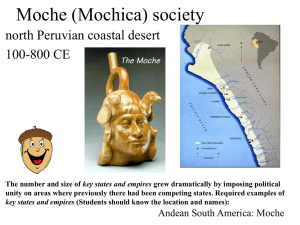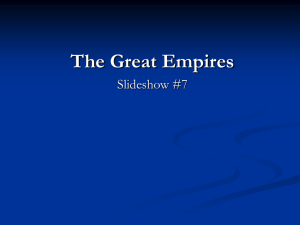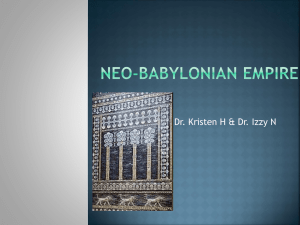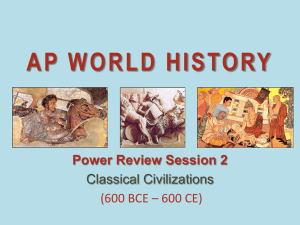Moche and beyond
advertisement
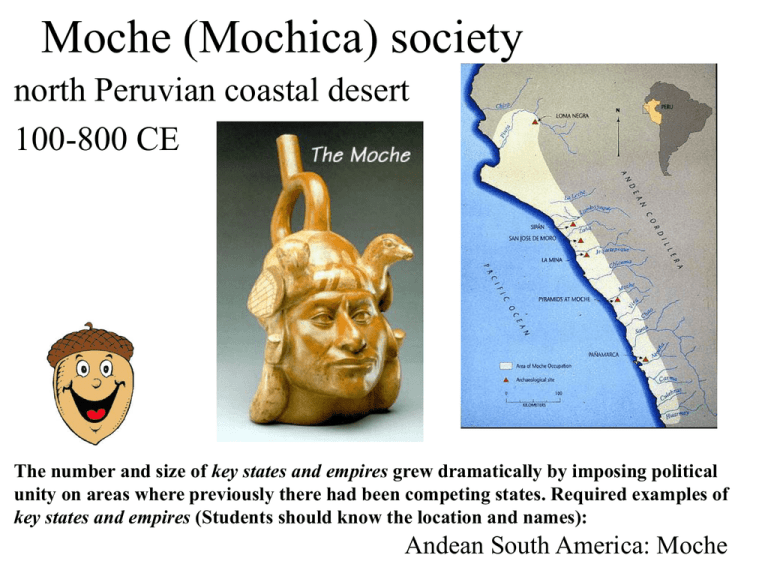
Moche (Mochica) society north Peruvian coastal desert 100-800 CE The number and size of key states and empires grew dramatically by imposing political unity on areas where previously there had been competing states. Required examples of key states and empires (Students should know the location and names): Andean South America: Moche • Developed a powerful elite and specialized craft production • instituted labor tribute* payments. • new technologies in metallurgy, pottery, and textile production, Royal Textiles Concept 2.2, III C. Imperial societies relied on a range of methods to maintain the production of food and provide rewards for the loyalty of the elites. Teach one illustrative example of such methods, either from the list below or an example of your choice: • Corvee • Slavery • Rents and tributes • Peasant communities • Family and household production Teotihuacán The number and size of key states and empires grew dramatically by imposing political unity on areas where previously there had been competing states. Required examples of key states and empires (Student should know the location and names): ,. . . • Mesoamerica: Teotihuacan, Maya city-states Cities served as centers of trade, public performance of religious rituals, and political administration for states and empires. Teach one illustrative example of cities, either from the list below or an example of your choice: • Persepolis , • Chang’an • Pataliputra• Athens• Carthage• Rome• Alexandria• Constantinople • Teotihuacan One of the largest cities of the world • Started building approx 100 BCE; lasted until sometime between the 7th and 8th centuries CE. • At its zenith, Teotihuacan largest city in the pre-Columbian Americas. • more than 200,000inhabitants • multi-floor apartment compounds How about: Oh crap those messy Mayans Mayan City-__________ of Mayan Civilization Classical era : 200-900 CE The ruins of Palenque. Codex (Books) Mayan Technology’s role in state building Most lands occupied by the Maya were poorly drained lowlands with poor soil. To improve agricultural production, the Maya constructed terraces, which trapped silt carried by rivers and so retained rich earth for planting, thereby allowing their expansion and population growth. Persia basis of agriculture was the labor of free farmers and tenants and in handicrafts the labor of free artisans Small number of slaves from conquered populations Satrapies collected tribute Major Developments: 200 CE to 600 CE Collapse of empire; Han china, western portion of Roman empire, Gupta Collapse of empire was more severe in _______ Europe than it was in the ________Med or China SIMILARITIES Several common factors caused H, R and G empires to fall: Attacks from ___________ or migratory groups Their migration was probably caused by drought and lack of pasture, and the invention and use of the s__________facilitated their attacks on all three established civilizations. Deterioration of political institutions - All three empires were riddled by political ___________during their latter days, and all three suffered under weak-willed rulers. Moral decay also characterized the years prior to their respective falls. Protection/maintenance of __________- which had grown so large that their military had trouble guarding them. A primary example is the failure of the Great Wall to keep the Huns out of China. The Huns generally just went around it. __________that followed the trade routes - Plagues and epidemics may have killed off as much as half of the population of each empire. COMMON CONSEQUENCES ____________was disrupted but survived, keeping intact the trend toward increased long-distance contact. Trade on the ________ _________even increased as conflict and decline of political authority affected overland trade. (ooh ccot pt) The importance of ____________increased as political authority decreased. In the west religion, particularly______, developed authority in many areas of people's lives. ________also spread quickly in China, presenting itself as competition to Confucian traditions. DIFFERENCES in the effect of the fall The fall of the Gupta probably had the least impact, partly because political unity wasn't the rule anyway, and partly because the traditions of _________ and the ________system continued on after the empire fell. The fall of the Han Dynasty –takes several 100 years before next dynasty—but tho discredited, __________traditions continued to give coherence to Chinese society. Nomads (as usual) adopted Ch ways The most devastating fall of all occurred in the _______ part of the Roman Empire. Roman civilization depended almost exclusively on the ability of the government and the military to control territory. Even though __________emerged as a major religion, it appeared so late in the life of the empire that it provided little to unify people as Romans after the empire fell. Instead, the areas of the empire fragmented into small parts and developed unique characteristics, and the Western Roman Empire never united again. Spread of __________ Gupta Golden Age • • "[Sugar cane] was brought to the [Indian] subcontinent during the B.C.E., era but it was not until the Gupta period that someone in India discovered how to reduce the juice of the sugar cane into crystallized sugar and thereby began an industry that has played a significant role in history for more than a millennium." -Asia in Western and World History, by Ainslie T. Embree & Carol Gluck • records of knowledge of sugar among the ancient Greeks and Romans, but only as an imported medicine, and not as a food. • For example Dioscorides in Greek in the 1st century (AD) wrote: "There is a kind of coalesced honey called sugar found in reeds in India and Arabia Felix [Yemen], similar in consistency to salt and brittle enough to be broken between the teeth like salt. It is good dissolved in water for the intestines and stomach, and taken as a drink to help a painful bladder and kidneys." Key Concept 2.3 Emergence of Transregional Networks of Communication and Exchange With the organization of large-scale empires, the volume of long-distance trade _________ dramatically. Much of this trade resulted from the demand for raw materials and l________ goods. Land and water routes linked many regions of the E_________Hemisphere, while somewhat later separate networks connected the peoples and societies of the Americas. Exchanges of people, technology, religious and cultural beliefs, food crops, domesticated animals and disease pathogens developed alongside the trade in goods across far-flung networks of communication and exchange. I. Land and water routes became the basis for transregional trade, communication and exchange networks in the Eastern Hemisphere, while somewhat later separate networks connected the peoples and societies of the Americas. NOTE: Students should know how factors including the climate and location of the routes, the typical trade goods, and the ethnicity of people involved shaped the distinctive features of the following trade routes. A. Eurasian ________Roads B. Trans-Saharan c_________routes Check out that chart . . . . C. Indian Ocean sea lanes D. Mediterranean sea lanes The earliest evidence for domesticated ________ in the region about 7th cent BCE; late centuries BCE special camel _________ developed. Used by the B_______ people, they enabled more regular contact across the entire width of the Sahara. By 300s CE camels repalce donkey and horse. But . . . it was not until the 7th and 8th centuries, with the conversion of West Africa to I_______ that routes became regular. --- ooh CCOT point Who participated: Chinese, Indians, Malays, Persians, Arabs, East Africans Created a trading class with _________of cultures Imp of ___________; use of ________ sails II. New technologies facilitated long-distance communication and exchange. A. New technologies (such as yokes, saddles or stirrups) permitted the use of domesticated pack animals (such as horses, o______, l_______ or ca_______) to transport goods across longer routes. B. Innovations in maritime technologies (such as the l________sail or d_______ ships) as well as advanced knowledge of the ___________ winds stimulated exchanges along maritime routes from East Africa to East Asia. III. Alongside the trade in goods, exchanges of people, technology, religious and cultural beliefs, food crops, domesticated animals and disease pathogens developed across far-flung networks of communication and exchange. A. The spread of crops, including rice and cotton from South Asia to the Middle East, encouraged changes in farming and irrigation techniques (such as the development of the q________t system in Persia). B. The spread of disease pathogens diminished urban populations and contributed to the decline of some empires (such as Rome or China) C. Religious and cultural traditions were transformed as they spread including Chinese culture, Christianity, Hinduism and Buddhism. AKA great vehicle bodhisattvas , revere e Buddha influence in China and Japan Hsiung-nu—pastoral nomads originate in the ________ lived in areas that sedentary agriculture could not cuz not enuf rain, incursions into China, Gupta and Rome, played major role in rise and fall of empires in civilized cores—courage culture, kin-related bands, honor, vendettas, men dominate, short legged horses, some social stratification Where? New technologies permitted the use of domesticated pack animals to transport goods across longer routes. Teach one illustrative example of new technologies, either from the list below or an example of your choice: • Yokes • Saddles• Stirrups Teach one illustrative example of domesticated pack animals, either from the list below or an example of your choice: • Horses • Oxen • Llamas • Camels Horses in warfare The __________ which gives greater stability to a rider, has been described as one of the most significant inventions in the history of warfare, prior to gunpowder. As a tool allowing expanded use of horses in warfare, the stirrup is often called the third revolutionary step in equipment, after the chariot and the saddle. Chariots and archers were weapons of war in Ancient Egypt. The invention of the stirrup occurred relatively late in history, considering that horses were domesticated in approximately 4500 BC, and the earliest forms of the saddle—a simple blanket with light padding and a surcingle appeared about 800 BC. The Horse: a weapon • In most civilizations the horse was used more in chariots than for riding until about 800 BC. Before stirrups most equestrian cultures used no support for the feet at all. There are records of a loose surcingle being employed behind the girth, into which the feet could be tucked. Toe stirrups (loops of rope which held the big toe) were first recorded in Northern India in the 2nd century BC, their use was somewhat limited by climate and footwear. • The first stirrups designed to take the entire foot were probably single mounting stirrups recorded in China in the 4th Century AD. The mounting stirrup was easier than using a stool to mount and safer than vaulting on when fully armed (Cambyses, king of Persia stabbed himself while mounting when fully armed in 522 BC - A.D.H.Bivar, "The Stirrup and Its Origins." Oriental Arts, n.s. 1 (1955): 61-68. ) • • A rider supported by stirrups was less likely to fall off while fighting, and could deliver a blow with a weapon that more fully employed the weight and momentum of horse and rider. Among other advantages, stirrups provided greater balance and support to the rider, which allowed a mounted soldier (part of the cavalry) to use a sword more efficiently without falling, especially against infantry adversaries. The earliest manifestation of the stirrup was a toe loop that held the big toe and was used in India, possibly as early as 500 BC.This ancient foot support consisted of a looped rope for the big toe which was at the bottom of a saddle made of fibre or leather. Such a configuration was suitable for the warm climate of south and central India where people used to ride horses barefoot Real first stirrup was Kush—about 100 CE— founded by white Huns Appears in China in widespread use 400s Depiction of a Kushan divinity using an early platformstyle stirrup, circa AD 150. British Museum. Trans Saharan Trade gold, ivory trade, and salt sent north and east to population centers in North Africa, the Middle East and Europe in exchange for glassware, cloth, ceramics etc Although there are Classical references to direct travel from the Mediterranean to West Africa most of this trade was conducted through nomads (middlemen), inhabiting the area and aware of passages through the First mention of camels across _______comes in 46 bce, probably from Arabian peninsula by way of Egypt Trans Saharan Trade and Carthage Carthage founded c. 800 BCE, one terminus for West African gold, ivory, and salt. Even after fall of Carthaginian Empire Trade continued into Roman times. Innovations in maritime technologies, as well as advanced knowledge of the monsoon winds, stimulated exchanges along maritime routes from East Africa to East Asia. Teach one illustrative example of innovations in maritime technologies, either from the list below or an example of your choice: • Lateen sail • Dhow ships • Add east weast point from ap curriculum The Mediterranean runs east-west, and so there is little variation in its ecology. Some bits are wetter and some drier, but mostly it’s all “Mediterranean.” By contrast, the Indian Ocean includes environments as varied as tropical East Africa, the deserts that border the Red Sea and Persian Gulf, the intensely wet areas of southern India, and the tropical rainforests of Southeast Asia. This ecological variety served as a stimulus to trade. The Persian Gulf had little in the way of timber, but the teak forests of India and the mangrove swamps of East Africa were only a month away by ship. Horses do not thrive in southern India, but they were needed for military purposes. Arabian horses were exported by ship to the ports of southern India to meet this need. Spices and incenses grew only in a few favored places. P_______was grown throughout southern India, but some of the more valuable spices like nutmeg and cloves were produced in a few little islands in Southeast_______. Frankincense comes from a few places in South Arabia and the Horn of Africa. These goods, however, were desired throughout the Indian Ocean and beyond. The ecological diversity of the region is paralleled by its human diversity. Because of its size, the Indian Ocean connects several regions of Africa, Southwest Asia, South Asia, Southeast Asia, and, to a degree, East Asia. People in these places eat different foods, dress differently, talk differently, build their houses differently, and perhaps most tellingly build their boats differently. Despite their differences, these regions and the people in them were, for most of their history, in regular and intimate contact with each other. What the Trade in the Med First, Phoenicians Then Greeks Carthage and Romans 3 2 1 4 9 8 7 6 Teach one illustrative example of cities, either from the list below or an example of your choice: • Persepolis , • Chang’an • Pataliputra• Athens• Carthage• Rome• Alexandria• Constantinople • Teotihuacan 3 4 9 2 8 7 5 1 6 Teach one illustrative example of cities, either from the list below or an example of your choice: • Persepolis (8) , • Chang’an (7) • Pataliputra•(6) Athens (3)• Carthage (2) Rome (4)• Alexandria (5)• Constantinople (9) • Teotihuacan (1) First Persian Empire Achemenids– founded by Cyrus the Great (r. 558530 BCE) created largest known empire • CLASSICAL CHINA Qin Dynasty 221- Han Dynasty 202 BCE 202 BCE to 220 CE The Location . . .
